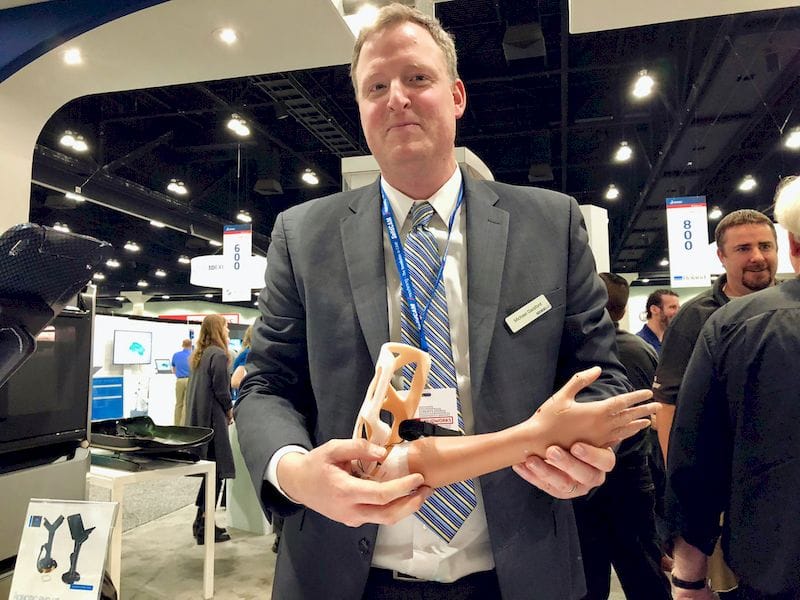
We spoke at length with Stratasys’ Director of Marketing for Healthcare Solutions, Michael Gaisford.
While the conversation centered around their partnership with Unlimited Tomorrow’s Easton LaChappelle to produce sophisticated 3D printed prosthetics, we ventured into several other aspects of 3D printing in the healthcare vertical.
This is part 2 of a 2 part interview. Part 1 is here.
Fabbaloo: We did an interview with Daniel Richards from Lancaster University who is working on this front end of a voxel-based design tool. This is the part I’m interested in. Would Easton, if he had something like that avaialble, be able to design a far more interesting project?
Michael Gaisford: On the power of the VoxelPrint interface that we’ve set up, the weakness is that that doesn’t have a very easy user interface right now. But you can if you’re scaling an application like this. His goal is not dozens of arms or hundreds of arms, it’s hundreds of thousands, maybe millions of arms. He can create his own custom workflow, which is what he’s already doing with his 3D scanner and the the work he’s doing with Dassault and others, he can create his own custom workflow that will then tap into VoxelPrint. We’re not forcing it into a certain workflow. The weakness we don’t have an easy to use interface, however he can customize his workflow so that it takes advantage of the capabilities.
Fabbaloo: Once voxel level design software actually comes out, what sort of medical applications you think might appear?
Michael Gaisford: I think it’s going to be building on the applications we’ve already seen. For example, being able to create patient specific models and go from DICOM to 3D print without having to have that intermediate STL, which loses a lot of data. For example, if you’re going to scan somebody’s fracture, somebody’s arm and you turn that into an STL file you lose all that information about the the density of the bone and perhaps elements that are inside of the bone that you might not have seen. If you lose that data in that STL translation, it’s gone.
But now you’ll be able to go directly from DICOM to 3D print and maintain that level of data. I think creating more realistic models for radiological interpretation, to be able to do clinical programs that are that are taking advantage of that is one application. To be able to create more realistic behaving models so that they have the same biomechanical response, again by incorporating the complexity of the voxel level design and having, for example, microstructure of the bones that when you place a screw into it, you’ll feel that haptic feedback.
Fabbaloo: Materials for human implantation. I don’t know that Stratasys have done that yet and I don’t think implantation is on your current list of three medical applications.
Michael Gaisford: No, I was focusing on applications today, than them thinking about the future. There are models for patient surgical planning and then models either for training physicians or for testing devices. The third was that was you know the prosthetics and orthotics opportunity as well.
Fabbaloo: None of those involve implantation?
Michael Gaisford: No, we don’t have materials that have that classification to be suitable for implants
Fabbaloo: Would that be something you might do in the future?
Michael Gaisford: Absolutely.
Fabbaloo: That would open up a whole new area?
Michael Gaisford: I think there’s a whole a whole other opportunity for advancing materials, especially on the PolyJet system, because it has that voxel level control and the ability to create digital materials. If we can get to the point where we have materials that can be placed in the human body or withstand even more mechanical force and manipulation that will be huge. It’s not currently possible with our current technology but it’s something we’re we’re investing in.
Fabbaloo: It’s technically feasible though?
Michael Gaisford: Yes, yes, yes.
Fabbaloo: Another technically feasible notion would be electrically conductive material. Could you speculate on what that might might do in the healthcare area?
Michael Gaisford: It is something that we get asked for frequently. For example, in the prosthetics they would want to be able to embed the circuitry, rather than having to put the wires and circuits in after printing. Why not print it all at once so that the circuitry and electronics are built into it? There’s certainly a strong demand there from prosthetics or orthotics. We have regular feedback regarding our anatomical models, in that people would like to deliver energy into them because a lot of medical devices deliver RF energy, ablation or mabye to conduct electricity through them for the operation of the device. They want to be able to have a heart that that is beating and has electrical conductivity in it.
Yeah, there’s certainly a huge opportunity there. But again we’re not there yet.
Fabbaloo: How big is the health care segment for Stratasys? It’s not like half of your business? What is it?
Michael Gaisford: Our investor relations group does not break out our revenues in the Medical and Healthcare side.
Fabbaloo: Is it a rapidly growing segment?
Michael Gaisford: It’s absolutely one of our pillars of investment. That’s been clearly communicated: we’re focused on manufacturing, education and in the healthcare space both in medical and dental. It’s absolutely great.
This is part 2 of a 2 part interview. Part 1 is here.

